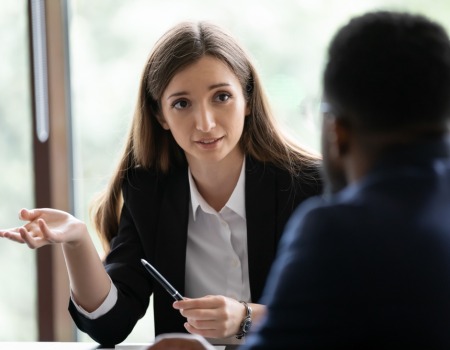How to give peer feedback that won’t upset your colleague
 Meaningful feedback helps people learn and grow as professionals. Thus, if you notice colleagues doing something wrong or have ideas on improving peers’ work, you should speak up immediately.
Meaningful feedback helps people learn and grow as professionals. Thus, if you notice colleagues doing something wrong or have ideas on improving peers’ work, you should speak up immediately.
Not so fast. While constructive feedback from those closest to their work often does prove useful, only some people welcome peer feedback with open ears.
Some get embarrassed, others see it as intrusive, and nobody particularly enjoys hearing negative comments.
The temptation exists to stay silent and leave feedback responsibilities to managers. Occasions arise, though, where a co-worker’s actions affect your own performance or the team, and saying something feels necessary.
Likewise, many workplaces expect such feedback conversations among team members. They view quality feedback as critical to creating a learning environment and even make peer assessment part of the annual performance review process.
Think of the ability to share feedback as a valuable skill. The following tips can make it easier and increase the odds of the recipient taking your message to heart.
The importance of positive feedback
Since people like it when others notice good things about them, work on developing a reputation as someone who points out positive things. Kudos and appreciation play a critical role in creating an effective feedback culture.
Telling co-workers what they are doing well encourages them to keep up the good work. It also sets a foundation for times when what you want to say is unpleasant.
Colleagues know you are an honest person capable of recognizing strengths and weaknesses, not someone out to pick on others.
Make positive feedback specific so the receiver knows you are genuine and not just out to get on her good side. Vague praise can come off as phony and does little to let the person know what you find worthy of commendation.
Consider formulating statements such as:
-
I appreciate how you (e.g., give me a heads-up when plans change, pay such close attention to detail, make everyone in the group feel like part of the team).
-
I’ve noticed you (are really diligent about deadlines, put a lot of thought into organizing things, are good at drawing others out of their shell, etc.).
-
I feel you are exceptional at (handling challenging clients, diffusing tense situations, producing error-free reports, etc.).
Tips for delivering negative feedback
While nobody’s favorite thing to do, sometimes a situation demands alerting a colleague to a shortcoming or problem. If, for instance, failure to complete his part of a project is holding up your end, suggestions on how to pick up the pace could get both of you out of a jam.
Or, perhaps a teammate wants your opinion on a letter to a major client he drafted. Of course, he would love to hear that the writing is perfect, but honest feedback about how to revise it ultimately leads to a better outcome.
Here are seven strategies to deliver effective feedback.
Practice beforehand if possible
Nerves may get the better of you without preparation. Think in advance about what you want to say. What is the goal of your conversation and the desired outcome? Figure out key points so you can stick with them rather than rambling.
In the same way, if asked to participate in a peer review process, draft what you want to write rather than immediately filling out the template presented. This allows you to reread comments and tweak them before handing them in.
Choose the setting wisely
Conduct feedback conversations in private. The recipient may think you are out to embarrass her if you present negative feedback in front of others. The person also could conclude that you deliberately chose to talk in public in the hope that more individuals would be able to chime in. The end result could be feeling like team members are ganging up.
“When offering constructive criticism to co-workers, I find it helpful to create a safe space for them to process the information,” says Dillon Morrison, founder and editor at Outlighter. “Make sure you and the worker have sufficient time to talk. For instance, you may feel rushed and stressed if your day is jam-packed with meetings. Have the meeting in a private area, like your office, and promise that everything spoken will be held in the strictest confidence.”
Ask for permission to present feedback
 Eliminate surprises by saying, “I have some thoughts I’d like to share. Are you open to feedback?” This action conveys respect and helps make what follows not seem like an unwanted lecture.
Eliminate surprises by saying, “I have some thoughts I’d like to share. Are you open to feedback?” This action conveys respect and helps make what follows not seem like an unwanted lecture.
“The best strategy to provide negative feedback to colleagues is approaching it in a humble manner,” says Tim Connon, founder of ParamountQuote Insurance Advisors. “People always react based on how they are approached. This means if you approach them humbly and with humility, they are more inclined to respond in a similar manner. When you phrase your feedback, include that you do not want to sound rude. This helps set the premise for how you are approaching it. Focus on making your intentions clear, such as that you are not trying to make your colleague feel dumb but are trying to help. This will make all the difference.”
Permission is already assumed in cases where a peer has contacted you to ask for feedback. A good way to lead into your requested feedback is something like “Thank you for trusting me. I’ll do my best to be honest and helpful.”
Resist anger and judgment
Control your emotions. Someone who feels threatened will likely become defensive immediately and stop listening. Likewise, don’t criticize someone’s personality or make assumptions about why they do certain things. Instead, stick to facts. Saying, “I can’t finish my part of the report until I receive your data, so can I make a suggestion on how to speed things along?” is very different from blurting out, “You are sabotaging the whole project by collecting data in such an inefficient way.” Concentrate on the problem, not the person.
“Focus on the facts,” suggests Jon Stephens, director of operations for Snowshoe Vacation Rentals. “Try to leave your opinion out of your feedback as much as possible, and limit yourself to strictly what you have observed. This makes your feedback feel far less personal, making it easier for your colleague to process it without feeling defensive.”
Avoiding “you” statements also reduces the likelihood of appearing accusatory. Saying, “You made three errors in the report,” draws attention to the person. Stating “The report contained three errors” shifts the emphasis to the document.
“To make delivering negative peer feedback less awkward, approach it like a disagreement with a good friend,” suggests Andy Kalmon, CEO of Benny. “You can focus on describing what you felt/observed rather than making it personal. For example, instead of saying: ‘You don’t communicate promptly,’ you could try saying, ‘I have noticed an opportunity to improve the timeliness of your communication.’ This subtle shift in focus makes it harder for someone to feel attacked by your feedback, which can make them more receptive to hearing it.”
Empower them to change.
Use language that encourages action but does not come off as dictatorial. Put the ball in their court with phrases such as:
-
Have you considered . . .?
-
What if we were to try . . .?
-
What if next time . . .?
-
Do you see other options that might result in better . . .?
Also, try to encourage seeing the possibilities rather than looking like you’ve come in with a list of gripes.
“Address problems in a way that makes them seem surmountable,” suggests Carter Seuthe, CEO of Credit Summit. “Simply offering criticism is likely to receive a defensive reaction, while structuring feedback in a way that includes potential solutions or actionable steps is more likely to be received well.”
Use emotional intelligence
Employ your best communication skills. Listen to responses. Watch body language and tone to judge the recipient’s understanding of your words. Ask if there is anything you can do to help. Be empathetic by putting yourself in the other person’s shoes to experience feedback from their perspective.
“When delivering constructive criticism to co-workers, I find that active listening is the most effective tactic,” says Jamie Irwin, digital marketing expert at TutorCruncher. “Every person experiences problems or setbacks in life. Giving time and space to clarify their situation makes them more likely to feel heard and valued. Building trust also requires demonstrating sympathetic behavior. Reading and responding to others’ emotions is crucial in any conversation. You may learn a lot if you take the time to hear them out.”
Adds Andre Kazimierski, CEO of Improovy Painters Madison, “I think generally when giving negative peer feedback, it’s important to modify your approach so you aren’t assuming a position of authority or talking down to someone. Instead, approach the feedback from a sympathetic standpoint and offer some ideas for how they can approach any needed changes.”
Get feedback on your feedback.
Ask if what you are saying makes sense. This question displays concern, promotes understanding, and eases some of the potential tension by making you open to critique. Showing your own willingness to accept constructive criticism sets a positive example.
Other considerations
Offering constructive criticism can be stressful for both the one giving and the one receiving. Often, it pays to think about whether or not you are the best person to deliver useful feedback, especially if the conversation seems out-of-place or beyond the scope of your job.
“I think in general, especially if you’re addressing an ongoing issue or complaint, it’s important to involve HR or leadership in this type of thing unless it’s been specifically requested,” Seuthe says. “Unrequested feedback from a colleague has a tendency to go over badly even with the most reasonable coworkers.”
Lastly, think about your relationship with the other person. If the connection is not positive, working on that bond first may be a better plan than presenting feedback.
“If you want to be able to give clear, effective feedback to your co-workers, there is absolutely no substitute for building a genuine, trusting relationship with them first,” says Ann Martin, director of operations of CreditDonkey. “This is especially true for negative feedback.
The more you can find the time to have positive interactions with each other, whether during the workday, over lunch, or in occasional after-hours socializing, the better off you’ll both be when it comes time to have tough conversations.”
Additional resources – Opens in new tab:
Interview feedback: Why and how you should provide it ![]()
Manager feedback questions to ask your employees and improve your leadership ![]()
Workplace feedback: The backbone of effective communication ![]()




